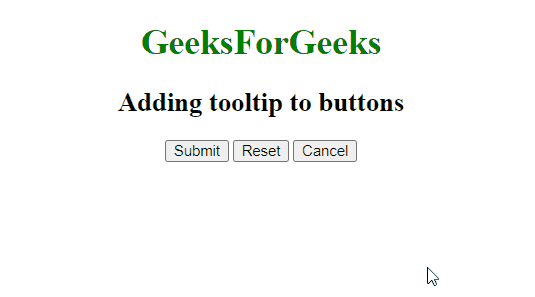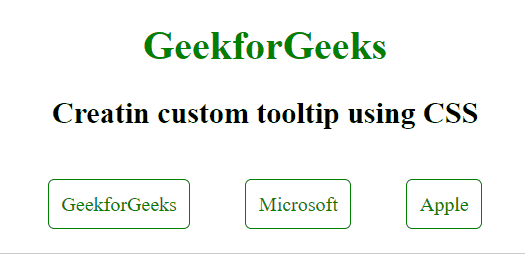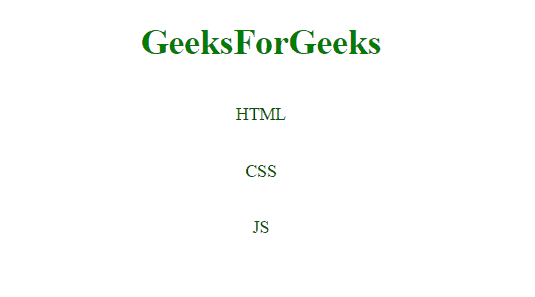|
A tooltip in HTML is a small pop-up box or text that appears when a user hovers over an element such as a button, link, or image. Tooltips are often used to provide additional information about the element or give the user context. We can create a tooltip using several methods, including the title attribute, CSS hover effects, and CSS pseudo-elements.
We can create a tooltip using the below methods:
Creating a Tooltip Using the title attributeIn this approach, we use the title attribute in HTML to provide additional information about an element. This information is typically displayed as a tooltip when the user hovers over the element with their mouse
Syntax:<element title="tooltip text">
Example 1: In this example we styles headers, and adds tooltips to buttons. It includes titles for the page and buttons, with the text “GeeksForGeeks” in green and tooltips for user guidance.
HTML
<!DOCTYPE html>
<html lang="en">
<head>
<meta charset="UTF-8">
<meta name="viewport"
content="width=device-width,
initial-scale=1.0">
<title>
Centered Content
</title>
</head>
<body>
<div style="text-align: center;">
<h1 style="color: green;">
GeeksForGeeks
</h1>
<h2>
Adding tooltip to buttons
</h2>
<button title="Tooltip for submit button">
Submit
</button>
<button title="Tooltip for Reset button">
Reset
</button>
<button title="Tooltip for Cancel button">
Cancel
</button>
</div>
</body>
</html>
Output:
Creating a Tooltip Using CSS hover effectThis approach utilizes CSS hover effect properties to create a tooltip. We create a hidden element that becomes visible when the user hovers over an element. The visibility and opacity properties are used to show and hide the tooltip.
Example: The below code practically implements CSS hover effect to create a custom tooltip for an element.
HTML
<!DOCTYPE html>
<html>
<head>
<title>
Link Tooltip Example
</title>
<style>
.tooltip {
position: relative;
display: inline-block;
text-align: center;
margin: 20px;
padding: 10px;
border: 1px solid green;
border-radius: 5px;
}
.tooltip a {
color: green;
text-decoration: none;
}
.tooltip .tooltiptext {
visibility: hidden;
width: 120px;
background-color: #555;
color: #fff;
text-align: center;
border-radius: 6px;
padding: 5px;
position: absolute;
z-index: 1;
bottom: 125%;
left: 50%;
transform: translateX(-50%);
opacity: 0;
transition: opacity 0.3s;
}
.tooltip:hover {
background-color: green;
}
.tooltip:hover a {
color: #fff;
}
.tooltip:hover .tooltiptext {
visibility: visible;
opacity: 1;
}
</style>
</head>
<body style="text-align: center;">
<h1 style="color: green; text-align: center;">
GeekforGeeks
</h1>
<h2>
Creating custom tooltip using CSS
</h2>
<div class="cont" style="text-align: center;">
<div class="tooltip">
<a href="#" class="link">
GeekforGeeks
</a>
<span class="tooltiptext">
Visit GeekforGeeks
</span>
</div>
<div class="tooltip">
<a href="#" class="link">
Microsoft
</a>
<span class="tooltiptext">
Visit Microsoft
</span>
</div>
<div class="tooltip">
<a href="#" class="link">
Apple
</a>
<span class="tooltiptext">
Visit Apple
</span>
</div>
</div>
</body>
</html>
Output:

Creating a Tooltip Using pseudo-elementsCSS pseudo-elements are used to add extra content either before or after the specified element. They are known as pseudo-elements because they add content without adding an element to the HTML DOM.
Example: The below code implements the CSS pseudo elements to create a tooltip.
HTML
<!DOCTYPE html>
<html>
<head>
<title>
Abbreviation Tooltip Example
</title>
<style>
.tooltip {
position: relative;
display: inline-block;
color: green;
}
.container {
text-align: center;
}
.tooltip::after {
content: attr(data-tooltip);
visibility: hidden;
width: 150px;
background-color: black;
color: white;
text-align: center;
border-radius: 6px;
padding: 5px 0;
position: absolute;
z-index: 1;
top: 100%;
left: 50%;
transform: translateX(-50%);
opacity: 0;
transition: opacity 0.3s;
}
.tooltip:hover::after {
visibility: visible;
opacity: 1;
}
</style>
</head>
<body>
<div class="container">
<h1 style="color: green">
GeeksForGeeks
</h1>
<h2>
Adding tooltip using pseudo selectors
</h2>
<p class="tooltip"
data-tooltip="HyperText Markup Language">
HTML
</p><br/>
<p class="tooltip"
data-tooltip="Cascading Style Sheets">
CSS
</p><br/>
<p class="tooltip" data-tooltip="JavaScript">
JS
</p>
</div>
</body>
</html>
Output:

Tooltips enhance user experience by providing additional information. They can be created using the `title` attribute for simplicity, CSS hover effects for customization, or CSS pseudo-elements for advanced styling. Each method offers unique benefits, enabling effective context delivery in web applications.
|


